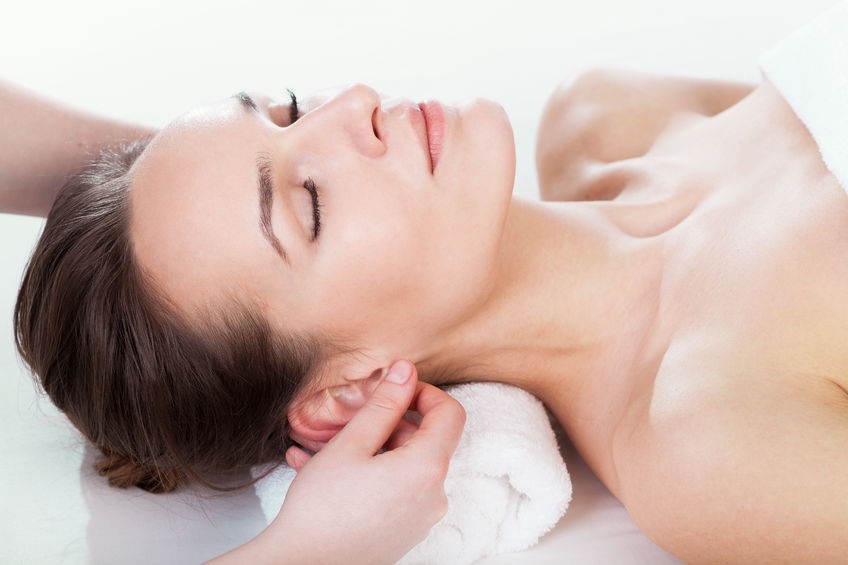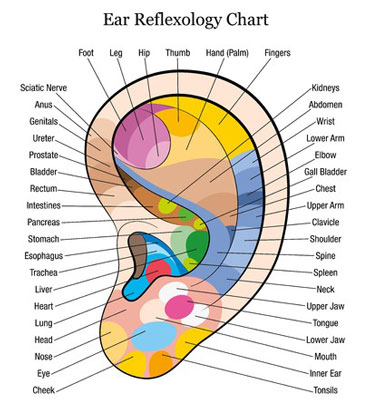The benefits of ear massage for stress
Ear massage or ear reflexology, also known as auriculotherapy, works to relieve stress by stimulating these ear pressure points, together with the ear massage itself producing the following responses and benefits:
- Nerve sensations that resonate through the whole body
- A feeling of happiness from transmitting positive endorphins
- Enhanced immune system from stimulating the senses
- Improved skin quality from stimulated skin
- Relaxing sensations from the therapeutic touch of massage
Various movements can stimulate these acupressure points, and many of us may already employ the benefits of ear massage without being conscious of it. It is quite common to tug at the ears, play with them, or fiddle with them when one is nervous or deep in thought, as this act of touch can offer calming relief for the individual and help relax them at particular times.
This proves that you don’t need to understand why exactly ear massage is so beneficial to reap the benefits – rubbing, tugging, pulling, pressing and rolling the ear cartilage and lobes all produce soothing effects, and you can experiment with what feels nice for you: hard, soft, with or without oils, all over or just one part such as the lobes or the outer edges of the cartilage.
All our bodies are different and respond in unique ways to touch so see what feels most relaxing for you, and try out some of our suggested ear massage moves below if you’re looking for some inspiration!
You can use ear massage anytime to relax, rejuvenate and release natural endorphins into your body, making you feel happier, more alert, and best of all - less stressed.
![Ear Reflexology Chart | Ear Microsystem Mapping Part of Ear to Body Parts Ear Reflexology chart mapping parts of the ear to part of the body ear microsystem]() Why ear massage is so powerful
Why ear massage is so powerful
One of the main reasons why ear massage (also known is so incredibly powerful is that the skin of the ears themselves are particularly sensitive due to the ear having a great number of nerve endings – specifically the ear lobes.
The ear lobes (lobulus auriculae) contain many nerve endings, and since they are made up of tissue rather than cartilage like the rest of the ear (known as the auricle) they have a large blood supply. This blood supply is thought to be for helping us maintain our balance as well as keeping the rest of the ear cartilage warm, but through massage, the blood supply can be manipulated for the benefit of the whole body.
Ayurvedic medicine (also ‘Ayurveda’), a healing system over 3000 years old developed in India, revolves around the belief that our wellness and overall health depends on a careful ‘balance between the mind, body, and spirit’. Ayurveda, recognise that the marma (energy) points in your ears are connected to your organs and whole body, and that various parts of the ear are linked to other particular body parts. Other health professionals refer to the ear linking to the body in a similar way, defining the ear as a microsystem of the body as a whole and mapping certain parts of the ear to certain parts of the body (see Ear Reflexology Chart).
This works since nerves in the ear are linked with various nerve centres in the brain which each send different neurological pathways down the spinal cord, finally reaching different neurons around the body and affecting different body parts. In this way, ear massage can not only be utilised for treating stress, it can be used to treat a host of other physiological symptoms and ailments from pains and aches, to pathological disorders in the abdomen, chest, lower back, and feet.
Ear massage movements to try at home (or on the go!)
We think massage should be something that everybody can enjoy, and ear massage is extremely accessible given that it can be self-taught and self-applied. When we provide office massage or seated massage at events, our therapists will always end a session with a feel-good head and ear massage of only a few minutes - and that is often all it takes to feel the benefits. Try the below ear reflexology moves out for yourself and see what works for you!
Teach yourself ear massage
Learn some of the following ear massage moves so that you can use your favourites for 1-2 minutes next time you need to relax or feel more energised:
Rubbing the outer edges of the ear
Placing the top of the ear between the forefinger and thumb, rub the finger back and forth as you work your way down the edge of the ear. Rubbing stimulates the ear nerve endings and will increase blood flow to the area, bringing blood to the head and making you feel more alert and awake.
Ear pulling
For relaxing ear pulling, you can start either at the top of the ear or at the lobe. Placing the ear cartilage between the thumb and forefinger, gently hold the ear and pull it outward away from your head, letting the ear slide through your fingers until it is released. Take care to reach all the way to the spot behind the ear where the ear attaches to the side of your head before gently pulling away. This part behind your ear is particularly sensitive since it is not often touched. Work your way around the ear and back for a wonderful stress relieving move.
Ear lobe massage
There are a few ways to massage the ear lobes. Try some of these massage moves to see what you like the best.
Circular motions
Place your forefinger and thumb around your ear lobe. Keeping the forefinger still, move your thumb in a circular motion around the lobe. Now, do the same with the forefinger instead, keeping the thumb still. (It might help to imagine you have an ear piercing and that you are rubbing around the piercing hole.)
Lobe pulling
Starting at the bottom of the ear, pull the lobe down gently and as you work along the ear lobe, pull more and more out and away from the head.
Pinching or pressing
This is more formally known as acupressure, or focalised massage applied to pressure points. Around the lobe this can be very effective and it is very simple to do. Pinch the edge of your ear lobe between your forefinger and thumb and work your way around the edge of the lobe. You can even extend this move up around the edge of the full ear. You can also press or pinch in a circular movement around the fleshy part of the lobe.
Ear stroking
Lighter massage movements can be incredibly powerful at stimulating the nerve endings in particular body parts. Try tracing the outline of your ear, tracing the inner curves of your ear cartilage, and stroking around the whole ear at once with the fleshy parts of your fingertips. You can also stroke the spot behind the ear from the top down where the ear joins with the head for a wonderful relaxing effect.
The spot behind the ear
This part of the ear as mentioned earlier has a slightly heightened sensitivety since it is harder to get to and therefore touched less frequently. The skin behind the ear is also not as tough as other parts of the body, since this area is protected by the ear itself and this too makes it more sensitive. This can be likened to the skin between the fingers – another area of the body not frequently touched, it has a softer make up and a heightened sensitivity. Try stroking in between your fingers now to see for yourself. This spot behind the ear can similarly be stroked, pressed, pulled and pinched to deliver lovely sensations.
Stroking behind the ear
Stroke gently up and down the crease where the ear joins with the head
Pressing/pulling behind the ear
Press your finger firmly, dragging it down the crease and pulling the skin behind the ear down with it until it finally releases. You can continue pulling until you are far past the ear and reach under the jawline before you finally release.
Pinching behind the ear
Starting at the top of the behind the ear crease, gently grab some of the skin along the crease and pull away, letting it slip out from between your fingers as it wants to do so.
Moving the entire ear
Covering the ear with the palm of the hand and pressing inwards, rotate the whole palm (with the whole ear) in a circular motion. This will also give a slight side of the head massage, releasing endorphins and a beautiful relaxing sensation.
Folding up and unfurling the ear cartilage
This ear massage move is done by placing the palm on the whole ear (as in the move above). Then pressing onto the ear and sliding the palm downwards, the top cartilage of the ear should curl down and fold up. To unfurl, slide the palm back up the side of the head, pressing firmly enough to bring the ear with it, and you can end by a continued pull of the ear upwards, letting the palm slide slowly up along the side of the head until the ear is released completely.
We hope you enjoyed learning about how ear massage can help relieve stress, and that you find some of the moves above helpful and enjoyable!
Any friends feeling frustrated? Help them destress too
If you think you know someone who might also enjoy this article or could do with feeling a bit less stressed, do share it around – or you can show them some of the moves above to help them feel more happy, healthy and relaxed! This article was written by the massage experts at Sense Massage Therapy, the UK’s leading provider of office massage since 2000.

 Why ear massage is so powerful
Why ear massage is so powerful